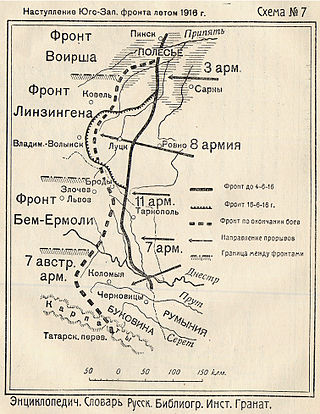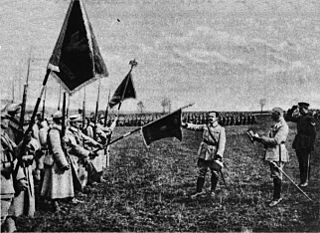Related Research Articles

The 1st Army was an army-level command of the Russian Imperial Army created during World War I. The First Army, commanded by General Paul von Rennenkampf, invaded East Prussia at the outbreak of war in 1914 along with the Second Army commanded by General Alexander Samsonov. After declaring war on the German Empire, the Russian Empire had been able to mobilize very quickly. All Russian forces were put under the command of Grand Duke Nikolai and his Quartermaster General Yuri Danilov.

The Polish Legions was a name of the Polish military force established in August 1914 in Galicia soon after World War I erupted between the opposing alliances of the Triple Entente on one side and the Central Powers on the other side, comprising the German Empire and Austria-Hungary. The Legions became "a founding myth for the creation of modern Poland" in spite of their considerably short existence; they were replaced by the Polish Auxiliary Corps formation on 20 September 1916, merged with Polish II Corps in Russia on 19 February 1918 for the Battle of Rarańcza against Austria-Hungary, and disbanded following the military defeat at the Battle of Kaniów in May 1918, against Imperial Germany. General Haller escaped to France to form the Polish army in the West against the anti-Polish German-Bolshevik treaty.

The Allies, or the Entente, were an international military coalition of countries led by France, the United Kingdom, Russia, the United States, Italy, and Japan against the Central Powers of Germany, Austria-Hungary, the Ottoman Empire, and Bulgaria in World War I (1914–1918).

The Imperial Russian Air Service was an air force founded in 1912 for Imperial Russia. The Air Service operated for five years and only saw combat in World War I before being reorganized and renamed in 1917 following the Russian Revolution.

The Allied leaders of World War I were the political and military figures that fought for or supported the Allied Powers during World War I.

This article lists Imperial Russian Army formations and units in 1914 prior to the mobilisation for the Russian invasion of Prussia and the offensive into the Austro-Hungarian province of Galicia.

The Russian Third Army was a World War I Russian field army that fought on the Eastern theatre of war.
The Russian Sixth Army was a World War I Russian field army that fought on the Eastern theatre of war.

The Northern Front was an army group of the Imperial Russian Army during the World War I. It was responsible for carrying out operations against the Central Powers along a front line that stretched 280 kilometers, from Riga in the north down to northern Belarus. It was established in August 1915 when the Northwestern Front was split into the Northern and Western Front following the Great Retreat, and existed until the demobilization of the Russian army in 1918 due to the unrest from the Russian Revolution. In 1917 it had a total troop strength of 1.4 million men.

The Southwestern Front was an army group of the Imperial Russian Army during World War I as part of the Eastern Front war theater.

While Poland did not exist as an independent state during World War I, its geographical position between the fighting powers meant that much fighting and terrific human and material losses occurred on the Polish lands between 1914 and 1918.
The Twentieth Army Corps was a formation of the Imperial Russian Army that was first raised in 1899, and most famous for fighting on the Eastern Front in World War I, most notably during the Second Battle of the Masurian Lakes. Before World War I, the 20th Corps was stationed in the Vilna Military District with its headquarters in Riga. At the outbreak of the war, the corps consisted of two infantry divisions and a number of independent battalions and brigades. Many Lithuanians served in this unit with the 28th Division having particularly many Lithuanians, especially in the 109th and 111th Infantry Regiments. Some regiments in this Corps were 80% Latvian. The corps was demobilized in April 1917.
The Northwestern Front was an army group of the Imperial Russian Army during the First World War. It was established in August 1914 and existed for one year prior to being divided into the Northern Front and Western Front.
The Western Front was an army group in the armed forces of the Russian Empire during the First World War. It was established in August 1915 when the Northwestern Front was split into the Northern Front and Western Front, and was disbanded in 1918. From the time of its formation until the final year of its existence, the Western Front's field headquarters was in Smolensk, but it was later moved to Minsk.
The Russian Fourth Army was a World War I Russian field army that fought on the Eastern Front.

The 10th Army was a field army of the Imperial Russian Army during the First World War.
The Russian Fifth Army was a World War I Russian field army that fought on the Eastern Front.
The Russian 11th Army was a World War I Russian field army that fought on the Eastern theatre of war.

The 11th Army was an army level command of the German Army in World War I. It was formed in March 1915 in Kassel originally to serve on the Western Front but was transported to Galicia for service on the Eastern Front. The army was dissolved on 8 September 1915, but reformed on 23 September 1915 for the Serbian Campaign. It was finally dissolved on 7 January 1919.

The 12th Army was a field army of the Imperial Russian Army during World War I that fought on the Eastern Front.
References
- ↑ "THE RUSSIAN ARMY, 1914". marksrussianmilitaryhistory.info. Retrieved 2022-06-05.